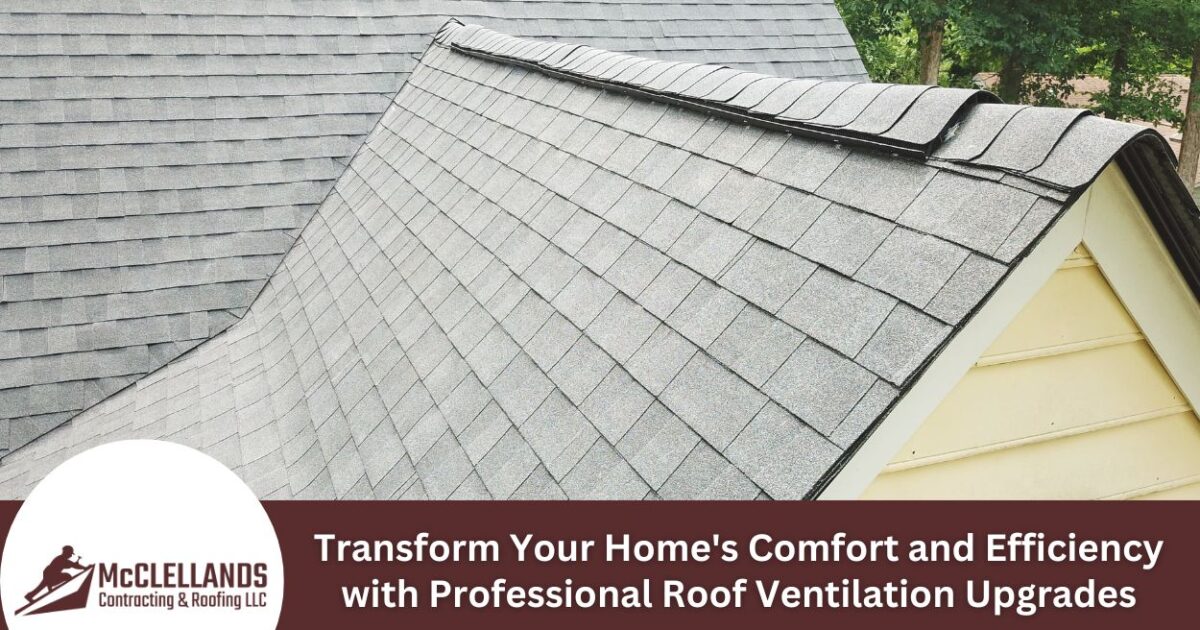Poor roof ventilation silently damages homes across the country, creating expensive problems that many homeowners don’t recognize until significant damage occurs. Inadequate attic ventilation systems trap hot air during summer and moisture during winter, leading to ice dams, mold growth, and premature shingle deterioration. These issues force heating and cooling systems to work harder, driving up energy bills while making the indoors less comfortable.
Roof ventilation upgrades address these problems by creating consistent airflow that protects both the structure and the family living beneath it. Ridge vent installation combined with strategically placed soffit vents creates a continuous airflow system that removes excess heat and moisture from the attic before damage occurs. Exhaust fan upgrades provide additional power for homes with complex rooflines or unique ventilation challenges.
Homeowners who invest in professional ventilation improvements generally experience immediate benefits, including lower energy costs, more consistent indoor temperatures, and better air quality throughout their homes. The investment extends your roof’s lifespan by preventing moisture-related deterioration and reducing the risk of expensive repairs. Ventilation also helps prevent ice dams during winter, protecting gutters and preventing water damage to interior spaces.
Essential Components of Modern Attic Ventilation Systems
Effective roof ventilation upgrades combine intake and exhaust components to create sufficient airflow patterns. Soffit vents serve as the intake system, drawing cool outside air into the attic space along the roof overhang. This incoming air travels upward through the attic cavity, collecting heat and moisture before exiting through exhaust points at the roof’s peak. Ridge vent installation provides the most efficient exhaust method, creating a continuous outlet along the entire roof ridge that allows hot air to escape naturally through convection.
The relationship between intake and exhaust components must maintain proper ratios to prevent airflow disruption that reduces ventilation effectiveness. Attic ventilation systems perform best when the intake area equals the exhaust area, ensuring adequate air replacement without creating negative pressure that draws conditioned air from living spaces. Improper balance forces ventilation components to work against each other, reducing overall system performance.
Different roof designs require specific ventilation configurations to achieve optimal results. Hip roofs benefit from exhaust fan upgrades when ridge length limits natural exhaust capacity, while complex rooflines with multiple peaks may need combination systems. Proper roof airflow depends on unobstructed pathways between soffit vents and ridge outlets, requiring careful attention to insulation placement and structural elements that might block air movement through the attic space.
Ridge Vent Installation for Superior Exhaust Performance
Ridge vents create continuous exhaust ventilation along the roof peak, establishing natural convection currents that remove hot air and moisture without requiring mechanical assistance. This passive ventilation system works by allowing heated air to rise naturally through the attic space and exit through the ridge opening, while cooler air enters through the soffit vents below. The continuous nature of ridge vents eliminates hot spots and dead air zones that occur with traditional exhaust fans or individual roof vents.
The design of ridge vents promotes consistent airflow across the entire roof structure, preventing moisture accumulation that leads to mold growth and structural deterioration. Unlike mechanical exhaust systems that operate intermittently, ridge vents provide constant ventilation that adapts automatically to temperature changes and seasonal conditions. This makes ridge vents particularly effective for roof ventilation upgrades in climates with extreme temperature variations.
Ridge vents are compatible with various roofing materials, including asphalt shingles, metal panels, and tile systems. Modern ridge vent designs feature weather-resistant materials and integrated sealing systems that prevent water infiltration while maintaining consistent airflow. The low-profile construction blends seamlessly with different architectural styles, from traditional Colonial homes to contemporary designs. Long-term maintenance requirements are minimal compared to mechanical exhaust fans, as ridge vents contain no moving parts that require service or replacement. The airflow created through ridge vent installation extends the roof’s lifespan while reducing energy costs.
Maximizing Intake Efficiency Through Strategic Soffit Vent Placement
Soffit vents create effective attic ventilation systems by establishing consistent air intake along the roof’s perimeter. Proper soffit vents create the driving force that pulls fresh air into the attic space, enabling the complete ventilation cycle that removes heat and moisture through exhaust points. The positioning and sizing of these intake components directly impact the overall system performance, making planning essential for optimal results.
Calculating adequate soffit vent sizing requires matching intake capacity to the attic’s square footage and the exhaust system. Building codes typically recommend one square foot of ventilation area for every 300 square feet of attic space, with intake and exhaust components sharing this requirement equally. This approach guarantees sufficient airflow to support ridge vents and other exhaust components.
Installation challenges may arise if insulation blocks soffit vent openings or structural elements limit placement options. Blown-in insulation commonly settles against soffit areas, creating barriers that restrict airflow even when vents are installed. Installing baffles between rafters maintains clear air channels while preventing insulation displacement that reduces ventilation effectiveness. Structural limitations such as narrow soffits or decorative elements may require creative solutions, including continuous strip vents or multiple smaller units strategically positioned to achieve proper roof airflow without compromising architectural aesthetics.
Power Ventilation Solutions and Exhaust Fan Upgrade Options
Mechanical exhaust fans become essential when natural ventilation systems cannot adequately address specific roof ventilation challenges. Complex architectural designs featuring multiple roof planes, limited ridge length, or inadequate soffit access often require powered ventilation for proper roof airflow. These situations commonly occur in homes with hip roofs, dormers, or additions that create ventilation dead zones where hot air and moisture accumulate despite correctly installed passive components.
Modern exhaust fan upgrades offer sophisticated control systems that optimize energy efficiency while providing reliable performance. Variable speed motors automatically adjust fan operation based on temperature sensors, increasing airflow when attic temperatures rise while reducing energy consumption during moderate conditions. Smart thermostat controls activate mechanical ventilation only when needed, preventing unnecessary operation that wastes electricity while ensuring adequate moisture and heat removal when needed.
Selecting appropriate fan capacity requires looking at attic square footage, existing ventilation components, and specific performance requirements. Oversized units create excessive air movement that disrupts natural ventilation patterns and increases operating costs, while undersized fans fail to provide adequate supplemental airflow. A professional assessment determines where the vents should be placed to complement existing attic ventilation systems. Proper integration of mechanical and passive components maximizes overall ventilation performance while maintaining energy efficiency throughout seasonal temperature variations.
Professional Installation Benefits and Long-Term Performance Optimization
Professional installation of roof ventilation upgrades ensures accurate airflow calculations that match your home’s specific requirements and characteristics. Experienced roofing contractors assess existing attic ventilation systems, measuring square footage, evaluating current ventilation components, and identifying structural factors that affect airflow patterns. This analysis determines the best placement for soffit vents and ridge vents and ensures your system complies with local building codes and manufacturer warranty requirements.
Expert installation teams understand how different ventilation components and existing roofing systems interact. They properly integrate new exhaust fan upgrades with current roof structures without compromising water-tight seals or creating structural weak points. Professional contractors also recognize potential installation challenges such as insufficient rafter spacing, conflicting utility lines, or architectural features that require modified approaches to achieve proper roof airflow.
Having a maintenance schedule preserves the ventilation system’s efficiency and prevents performance degradation over time. Regular inspection of soffit vents removes debris accumulation that restricts intake airflow, while ridge vent cleaning maintains unobstructed exhaust pathways. Professional monitoring identifies early signs of component failure, insulation displacement, or structural changes that compromise the system’s effectiveness. This prevents expensive problems from developing while maintaining optimal energy efficiency and moisture control throughout your home.
Learn About Roof Ventilation Upgrades with McClellands Contracting and Roofing, LLC
Don’t let poor attic ventilation compromise your home’s comfort and efficiency. McClellands Contracting and Roofing, LLC specializes in professional roof ventilation upgrades that tackle the root causes of moisture damage, energy waste, and premature roof deterioration. Upgrading your roof’s ventilation system can lead to significant improvements in your indoor air quality, reduce your energy bills, and extend the lifespan of your roof.
If you’ve noticed ice dams, musty odors, or uneven heating in your home, these could be signs that your roof ventilation system needs immediate attention. Our expert team at McClellands Contracting and Roofing, LLC can provide a comprehensive assessment and tailor a ventilation solution that fits your specific needs, whether it involves installing advanced ridge vents, soffit vents, or integrating powerful exhaust fans.
Take the first step towards a more comfortable and energy-efficient home today. Call McClellands Contracting and Roofing, LLC at (412) 353-5660 to schedule your professional roof ventilation assessment and upgrade.

